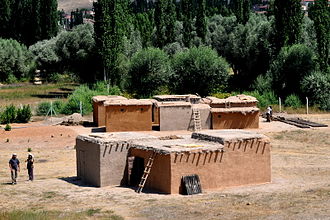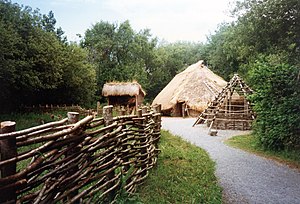 | |
| Period | Final period of Stone Age |
|---|---|
| Dates | c. 10,000 BC to c. 2,000 BC |
| Preceded by | Mesolithic, Epipalaeolithic |
| Followed by | Chalcolithic |
| Part of a series on |
| Human history and prehistory |
|---|
| ↑ before Homo (Pliocene epoch) |
| ↓ Future (Holocene epoch) |

The Neolithic or New Stone Age (from Greek νέος néos 'new' and λίθος líthos 'stone') is an archaeological period, the final division of the Stone Age in Europe, Asia, Mesopotamia and Africa (c. 10,000 BC to c. 2,000 BC). It saw the Neolithic Revolution, a wide-ranging set of developments that appear to have arisen independently in several parts of the world. This "Neolithic package" included the introduction of farming, domestication of animals, and change from a hunter-gatherer lifestyle to one of settlement. The term 'Neolithic' was coined by Sir John Lubbock in 1865 as a refinement of the three-age system.[1]
The Neolithic began about 12,000 years ago, when farming appeared in the Epipalaeolithic Near East and Mesopotamia, and later in other parts of the world. It lasted in the Near East until the transitional period of the Chalcolithic (Copper Age) from about 6,500 years ago (4500 BC), marked by the development of metallurgy, leading up to the Bronze Age and Iron Age.
In other places, the Neolithic followed the Mesolithic (Middle Stone Age) and then lasted until later. In Ancient Egypt, the Neolithic lasted until the Protodynastic period, c. 3150 BC.[2][3][4] In China, it lasted until circa 2000 BC with the rise of the pre-Shang Erlitou culture,[5] as it did in Scandinavia.[6][7][8]
- ^ "Neolithic". Oxford English Dictionary (Online ed.). Oxford University Press. (Subscription or participating institution membership required.)
- ^ Karin Sowada and Peter Grave. Egypt in the Eastern Mediterranean during the Old Kingdom.
- ^ Lukas de Blois and R. J. van der Spek. An Introduction to the Ancient World. p. 14.
- ^ "Neolithic Periods Overview". egyptianmuseum.org. Retrieved 2022-04-20.
- ^ Chang, K.C.: "Studies of Shang Archaeology", pp. 6–7, 1. Yale University Press, 1982.
- ^ Encyclopedia Britannica, "Stone Age"
- ^ Cavalli-Sforza, Luigi Luca; Menozzi, Paolo; Piazza, Alberto (1994). The History and Geography of Human Genes. Princeton, NJ: Princeton University Press. p. 351.
at first European contact .... [New Guineans] represented ... modern examples of Neolithic horticulturalists
- ^ Hampton, O. W. (1999). Culture of Stone: Sacred and Profane Uses of Stone Among the Dani. College Station, TX: Texas A&M University Press. p. 6.